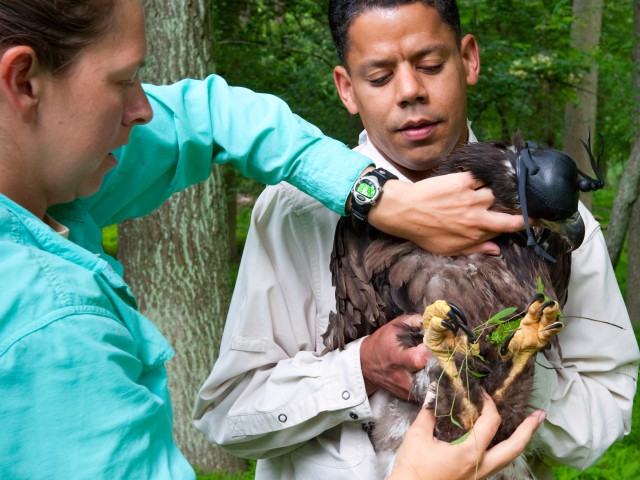ABERDEEN PROVING GROUND, Md. -- The Army is taking its role as environmental stewards seriously. A team of installation leaders and local environmentalists measured, tagged and weighed eaglets here May 29.
"The delicate balance of nature and protecting the environment is critical," said Garrison Commander Col. Orlando Ortiz.
Ortiz and his team are making a difference with the bald eagle banding program.
Experts from William and Mary College, APG environmentalists and security personnel trekked through on-post forests to see first-hand the importance of maintaining an environmental balance.
Research biologist Dr. Bryan Watts from the College of William and Mary climbed into the seven-foot wide bald eagle nest more than 60 feet off the ground. Watts then hooded two seven-week-old eaglets and lowered them individually to be measured, tagged and weighed. The 10-pound eaglets became docile once the hoods were securely in place, allowing safe handling by the team.
Safely on the ground, the team inspected the eagles. A female bald eagle is 20 percent larger then their male counterpart and easily identified by larger talons. Two leg bands were carefully fastened to the birds for identifying them in the future. A federally supplied aluminum band with alphanumeric information pertaining to the bird's origin and population was attached first. Secondly, a purple band with two large letters for easy identification designated the bird as a Maryland native.
The eaglets are in perfect health and should live a long life, said Libby Mojica, a research biologist with the Center for Conservation Biology at the College of William and Mary.
"We inspect for an abnormal amount of body parasites, which were not evident," Mojica said.
Federal officials are happy with the Army support.
"The Army has been given the task of managing the largest eagle population in the Chesapeake Bay," said Craig Koppie, U.S. Fish and Wildlife Service. "They've done this in an extremely impressive and admirable way."
The installation's location is perfect for a multitude of species because it is so close to the bay and its tributaries. Another factor in the eagle success rate is their access to a variety of prey which included other raptors, heron, snakes and fish, Koppie said.
Koppie also stated that a fetal pig and possibly some domestic road kill have been found in nests. One problem encountered with the increased eagle population was the high mortality rate caused by accidental contact with elevated power lines. The Army is now burying lines to solve this problem and the mortality rate has declined.
Ortiz helped to secure the eagles to be hoisted to their nest and promised to return for future bald eagle encounters.
"When you consider the missions that are executed here at APG and look at the success of the bald eagle program, we've done a great job and will continue to do so," Ortiz said.


Social Sharing